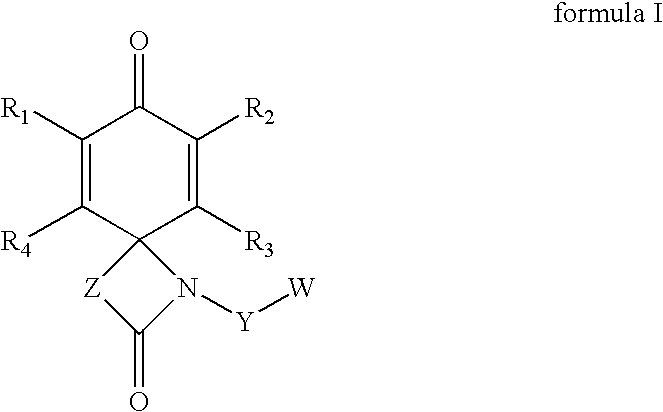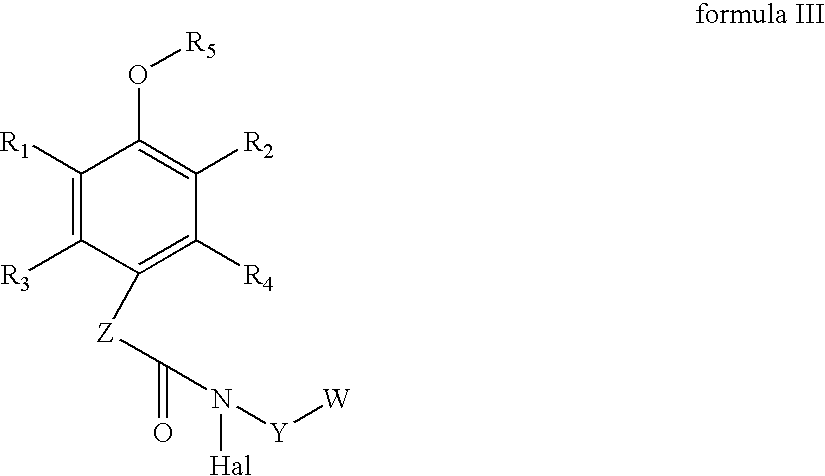Spirolactams and their synthesis
a technology of spirolactam and spiro-fused lactam, which is applied in the field of new spirolactam compounds, can solve the problems of limited stability of spiro-fused lactam obtained, limited yield, and limited application range of synthetic processes availabl
- Summary
- Abstract
- Description
- Claims
- Application Information
AI Technical Summary
Benefits of technology
Problems solved by technology
Method used
Image
Examples
example 1
General Procedure for the Preparation of the N-Alcoxyamides 3a-d from the 4-Methoxyphenylacetyl Chloride (1)
[0078]
[0079]The N-alcoxyamines 2a-c were purchased from Aldrich and Fluka Companies, and used without further purification. The N-alcoxyamine 2d was prepared following the procedure described in Brown, D. S.; Gallagher, P. T.; Lightfoot, A. P.; Moody, C. J.; Slawin, A. M. Z.; Swann, E. Tetrahedron 1995, 51, 11473-11488.
[0080]To a vigorously stirred solution of N-alcoxyamine hydrochloride 2a-d (17.87 mmol) and sodium carbonate (32.50 mmol) in a mixture of benzene (23 ml) and H2O (23 ml) with ice-water bath cooling, was added 4-methoxyphenylacetyl chloride (1). The mixture was stirred at room temperature for 12 h under an argon atmosphere and the progress of the reaction was monitored by TLC (hexane-AcOEt, 1:2). Then, AcOEt (50 ml) was added and the organic layer separated. This process was repeated three times. The combined extracts were washed with brine (2×50 ml), dried over...
example 2
N-Methoxy-4-methoxyphenylacetamide (3a)
[0081]The compound was obtained from 1 and 2a as described in Kawase, M. et al J. Org. Chem., 1989, 54:3394-3403 “Electrophilic aromatic substitution with N-methoxy-N-acylnitrenium ions generated from N-chloro-N-methoxyamides: syntheses of Nitrogen heterocyclic compounds bearing a N-methoxyamide group”.
[0082]Rf=0.14 (TLC, hexane-AcOEt, 1:2); yield, 99%; white solid, mp 86-87° C. (lit. mp 83-85° C.); 1H-NMR (200 MHz, CDCl3): δ 7.88 (1H, s br., NH), 7.19 (2H, d, J=8.7 Hz, H-2), 6.88 (2H, d, J=8.7 Hz, H-3), 3.81 (3H, s, OCH3), 3.71 (3H, s, NOCH3), 3.50 (2H, s, CH2); 13C-NMR (75 MHz, CDCl3): δ 169.1, 158.5, 130.1, 126.1, 113.9, 63.8, 55.1, 39.1; IR (KBr): ν 3467, 3159, 2967, 1644, 1612, 1513, 1252, 1063, 1033 cm−1; UV (MeOH): λmax (ε)=276 nm (1619 l.mol−1.cm−1); LRMS (EI): m / z 195 (M+, 3), 165(1), 160(1), 148(6), 135(4), 121(100), 91(23), 78(66); E.A. (C10H13NO3): calculated C, 61.53; H, 6.71. found C, 61.61; H, 6.76.
example 3
N—(O-Allylhydroxyl)-4-methoxyphenylacetamide (3b)
[0083]Following the same procedure as in example 1 but starting from 2b we obtained compound 3b.
[0084]Rf=0.30 (TLC, hexane-AcOEt, 1:2); yield, 99%; white solid, mp 100-101° C.; 1H-NMR (200 MHz, CDCl3): δ 7.85 (1H, s br., NH), 7.18 (2H, d, J=8.5 Hz, H-2), 6.87 (2H, d, J=8.5 Hz, H-3), 5.89 (1H, m, CH═CH2), 5.31 (1H, s br., CH═CH2), 5.25 (1H, s br., CH═CH2), 4.32 (2H, d, OCH2), 3.80 (3H, s, OCH3), 3.49 (2H, s, CH2); 13C-NMR (75 MHz, CDCl3): δ 169.1, 158.5, 131.9, 130.0, 126.2, 120.2, 113.8, 76.9, 55.0, 39.2; IR (KBr): ν 3467, 2967, 1641, 1609, 1514, 1253, 1057 cm−1; UV (MeOH): λmax (ε)=276 nm (2070 l.mol−1.cm−1); LRMS(EI): m / z 221(M+, 37), 180(3), 161(16), 148(33), 135(9), 121(100), 91(17), 78(31); E.A. (C12H15NO3): calculated C, 65.14; H, 6.83. found C, 65.21; H, 6.89.
PUM
| Property | Measurement | Unit |
|---|---|---|
| temperature | aaaaa | aaaaa |
| temperature | aaaaa | aaaaa |
| absorbing UV radiation | aaaaa | aaaaa |
Abstract
Description
Claims
Application Information
 Login to View More
Login to View More - R&D
- Intellectual Property
- Life Sciences
- Materials
- Tech Scout
- Unparalleled Data Quality
- Higher Quality Content
- 60% Fewer Hallucinations
Browse by: Latest US Patents, China's latest patents, Technical Efficacy Thesaurus, Application Domain, Technology Topic, Popular Technical Reports.
© 2025 PatSnap. All rights reserved.Legal|Privacy policy|Modern Slavery Act Transparency Statement|Sitemap|About US| Contact US: help@patsnap.com



